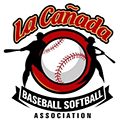FAQ's
What are the league geographical boundaries?
Where are games played?
When are the games played?
How often, and where, will my child practice?
When will practices begin?
When will the scrimmage / regular season games begin?
How long will the season last?
What equipment will my child need before the first practice or game?
Can my child be placed on a team with one of his friends?
If my child decided to quit, can I get a refund?
When and what is a player tryout / evaluation session?
If my child does poorly or misses at the player evaluation session will he/she be cut?
Can I keep my child down in a lower division?
Can my child “play-up” a year early?
When will I find out what team my child will play on?
My child has never played baseball before. If he’s not as good as the other kids, will he have a chance to play?
What kind of volunteer positions are available?
Please email us at lcbsa.webmaster@gmail.com for more details.
How is La Canada Baseball (played using PONY rules) different from Little League Baseball?
The primary features that distinguish La Canada Baseball from Little League Baseball are the use of a two-year age bracket system and scaled diamonds. In organizations such as Little League, players can differ by as much as three years within a division. As a result, the younger players because of their lack of maturity, ability, and size find it hard to communicate with the older players. Generally, they find themselves spending a disproportionate amount of time on the bench and may feel disconnected from their team. With players of only two ages involved, as is the case with La Canada Baseball, it is far easier to permit every player to play more positions since the skill levels are not as wide. Baseball is difficult to be played if the physical capability of the players does not match the physical achievements required for the game. Little League uses two diamond sizes. Up until age 12 players play on a 60-foot diamond, then they jump to 90-foot. La Canada Baseball, on the other hand, scales the size of their diamonds to match the physical capabilities of the players within each division.
The base and pitching distances for LCBSA are:
50-foot bases and 38-foot pitching distance for Pinto (7-8 year-olds)
60-foot bases and 44-foot pitching distance for Mustang (9-10 year-olds)
70-foot bases and 48-foot pitching distance for Bronco (11-12 year-olds)
90-foot bases and 60’6” pitching distance for Babe Ruth (13-14 year-olds)
These base dimensions are the result of extensive experimentation to determine the size on which players of each age group can properly play the game of baseball. Pitching distance is also scaled to the ability of the player in proportion to the size of the diamond. The scaled down diamonds allow the players to make the plays made by the major leaguers.Home runs become a possibility. Outfielders can play in a position proportionately equal to that played by a major leaguer, and the double play, squeeze play, and various strategy tactics, difficult for adults and nearly impossible for youngsters on a full size diamond, become a probability rather than impossibility.
What are the league geographical boundaries?
Children from all around the Foothill communities are welcome to play in LCBSA during the regular spring season!
If your child is interested and is selected to play on a divisional tournament “all-star” team at the end of the regular season, he must reside within LCBSA’s designated geographic boundary in order to play in PONY-sanctioned tournaments. If you have specific questions about LCBSA’s boundaries, please send an inquiry to our league email address: lcbsa.webmaster@gmail.com
Before Daylight Savings Time in early March, regular season games are generally played on Saturdays (with scrimmage games also played during the weeknight until natural light is no longer available). Then, when Daylight Savings Time is in effect, the Shetland through Babe Ruth divisions may play up to two games per week during the regular season, one weekday game and one Saturday game (with practices interspersed between games throughout the season). It is recommended that players arrive at the field at least 1/2 hour prior to game time so they can warm up and get ready for the game.
How often, and where, will my child practice?
When will the scrimmage / regular season games begin?
Scrimmage and regular season games may begin in mid-late February.
How long will the season last?
What equipment will my child need before the first practice or game?
Can my child be placed on a team with one of his friends?
If my child decided to quit, can I get a refund?
If my child does poorly or misses at the player evaluation session will he/she be cut?
Can I keep my child down in a lower division?
Can my child “play-up” a year early?
When will I find out what team my child will play on?
My child has never played baseball before. If he’s not as good as the other kids, will he have a chance to play?
What kind of volunteer positions are available?
Please email us at lcbsa.webmaster@gmail.com for more details.
